A Study on the Low-Intensity Cracking Resistance of Drainage Asphalt Mixtures by Graphene/Rubber Powder Compound Modified Asphalt
Abstract
1. Introduction
2. Test Materials and Methods
2.1. Test Materials
2.2. The Preparation of Modified Bitumen
2.3. Drainage Asphalt Mixture Grade Selection
2.4. The Fracture Energy Evaluation of Low-Temperature Crack Resistance
2.5. Low-Temperature Cracking Resistance Test
2.6. The Low-Temperature Crack Resistance Test After Freeze–Thaw Cycles
3. Experimental Results and Data Analysis
3.1. Marshall Stability
3.2. Fracture Energy at Different Temperatures
3.3. The Low-Temperature Cracking Resistance of SCB Tests
3.4. Low-Temperature Cracking Resistance After Freeze–Thaw Cycling
4. Graphene/Rubber Powder Composite Modified Asphalt Under Microstates
5. Conclusions
- (1)
- Under the condition of −15–0 °C, the magnitude of the fracture energy of drainage asphalt mixtures prepared by graphene/rubber powder compound modified asphalt was proportional to the temperature, and the inclusion of graphene improved the fracture energy by 15.68% of rubber powder-modified asphalt, which significantly slowed down the decrease of the fracture energy and improved low-intensity cracking resistance, as well as reduced the range of the mixture’s decreasing fracture energy with the decrease of the temperature.
- (2)
- When compared to rubber powder-modified asphalt, graphene/rubber powder compound modified asphalt improved the maximum stress by 7.50% and 26.71% at −15 °C and −10 °C, respectively. The introduction of graphene resulted in smoother stress changes in the mix at different temperatures, which improved the low-intensity cracking resistance and showed a superior low-intensity cracking resistance.
- (3)
- The crack strength of SCB specimens generally decreased after a freeze–thaw cycle. Rubber powder-modified asphalt specimens showed a decrease of 27.03% and 17.57% in maximum stress at −15 °C and 0 °C, and the trend was the same as that of the unfrozen and thawed specimens. SBS-modified asphalt specimens showed a decrease of 28.09% in maximum stress at −15 °C and a decrease of 14.84% at 0 °C, but a phenomenon of decreasing and then increasing at −5 °C, which showed the instability in low-temperature cracking resistance. The maximum stress of graphene/rubber powder compound modified asphalt specimens decreased by 21.51% and 10.37% at −15 °C and 0 °C, and the inclusion of graphene significantly slowed down the degree of decrease in the maximum stress compared with that of rubber powder-modified asphalt, and the decrease in split tensile strength was the smallest after the freeze–thaw cycle, and the inclusion of graphene improved the low-intensity cracking resistance at low temperatures.
- (4)
- In the microscopic state, the addition of graphene dispersed the aggregation of rubber powder, dispersed the irregular mesh aggregation morphology of rubber powder more uniformly into the asphalt, enhanced the intercalation of rubber powder and asphalt, and increased the connecting area between graphene/rubber powder and asphalt, and the low-temperature cracking resistance of graphene/rubber powder composite modified asphalt had a significant temperature-dependent property, with a critical temperature point of −10 °C. In the range of 0 °C to −10 °C, the crack resistance is maintained through the synergistic effect of graphene and rubber powder, while when the temperature is lower than −10 °C, the glass transition of the asphalt matrix and interfacial debonding are intensified, leading to the failure of the synergistic mechanism, and the cracks expand rapidly to dominate the damage.
Author Contributions
Funding
Institutional Review Board Statement
Informed Consent Statement
Data Availability Statement
Conflicts of Interest
References
- Li, H.; Hu, Y.; Shi, X.; Zhang, M.; Zhao, G.; Zou, X.; Sheng, Y. Influence of Rubber Powder Movement on Properties of Asphalt Rubber from the Mesoscopic View. J. Wuhan Univ. Technol. 2023, 38, 312–324. [Google Scholar] [CrossRef]
- Xue, H.; Cao, Y.; Liu, Q.; Zhang, H.; Zhang, M. Stability Evaluation and Mechanism of Asphalts Modified With Various Rubber Powder Contents. Front. Mater. 2021, 7, 622479. [Google Scholar] [CrossRef]
- Li, Y.; Bai, T.; Zhang, J.; Gao, Y. Advances in Regenerated Asphalt Mixtures. Materials 2023, 16, 2872. [Google Scholar] [CrossRef]
- Wang, X.; Hong, L.; Wu, H.; Liu, H.; Jia, D. Grafting waste rubber powder and its application in asphalt. Constr. Build. Mater. 2021, 271, 121881. [Google Scholar] [CrossRef]
- Ma, Q.; Guo, Z.; Guo, P.; Yang, F.; Li, H. Research on the Viscosity-Temperature Properties and Thermal Stability of Stabilized Rubber Powder Modified Asphalt. Sustainability 2021, 13, 13536. [Google Scholar] [CrossRef]
- Moreno-Navarro, F.; Sol-Sanchez, M.; Gamiz, F.; Rubio-Gamez, M.C. Mechanical and thermal properties of graphene modified asphalt binders. Constr. Build. Mater. 2018, 180, 265–274. [Google Scholar] [CrossRef]
- Xiang, H.; Wang, Z.; Deng, M.; Tan, S.; Liang, H. Adhesion Characteristics of an Asphalt Binder–Aggregate Interface Based on Molecular Dynamics. Materials 2025, 18, 981. [Google Scholar] [CrossRef]
- He, J.; Hu, W.; Xiao, R.; Wang, Y.; Polaczyk, P.; Huang, B. A review on Graphene/GNPs/GO modified asphalt. Constr. Build. Mater. 2022, 330, 127222. [Google Scholar] [CrossRef]
- Xie, Y.; Gao, Y.; Liao, M.; Tian, W. Study on the storage stability performance enhancement mechanism of graphene on rubber-modified asphalt based on size effect. Electron. Res. Arch. 2023, 31, 2048–2070. [Google Scholar] [CrossRef]
- Liao, M.; Gao, Y.; Xie, Y.; Zhu, J.; Li, Z.; Tian, W.; Zhu, Z. Investigation on the anti-aging properties enhancement mechanism of graphene on RA based on size effect. Case Stud. Constr. Mater. 2022, 17, e01634. [Google Scholar] [CrossRef]
- Wu, Z.; Huang, Y.; Gui, L.; Liang, L.; Ying, J.; Li, W.; Shen, P.K.; Tian, Z.Q. 3D porous graphene nanosheets as efficient additives for high-performance styrene–butadiene–styrene/crumb rubber blend-modified asphalt. Mater. Des. 2023, 232, 112157. [Google Scholar] [CrossRef]
- Adnan, A.M.; Wang, J. Enhancement of rheological performance and compatibility of tire rubber-modified asphalt binder with the addition of graphene. Constr. Build. Mater. 2023, 402, 133038. [Google Scholar] [CrossRef]
- Yong, P.; Tang, J.; Zhou, F.; Guo, R.; Yan, J.; Yang, T. Performance analysis of graphene modified asphalt and pavement performance of SMA mixture. PLoS ONE 2022, 17, e267225. [Google Scholar] [CrossRef] [PubMed]
- Guo, R.; Tang, J.; Gu, J.; Guo, G.; Feng, X. Analysis on the road performance of graphene composite rubber asphalt and its mixture. Case Stud. Constr. Mater. 2022, 17, e01664. [Google Scholar] [CrossRef]
- Liu, Y.; Duan, H.; Huang, Q. Multiscale effect of graphene oxide with short carbon fiber for property improvement of room temperature vulcanized silicone rubber. Polym. Bull. 2022, 79, 8471–8485. [Google Scholar] [CrossRef]
- Wu, J.; Li, F.; Ma, Q. Effect of Polyester Fiber on Air Voids and Low-Temperature Crack Resistance of Permeable Asphalt Mixture. Adv. Civ. Eng. 2020, 2020, 2381504. [Google Scholar] [CrossRef]
- Li, J.; Wang, S.; Liu, Y.; Lin, H.; Pei, R.; Muhammad, Y. Performance and mechanism evaluation of dopamine-hexamethylene diamine-iron tetraoxide composite rubber powder incorporated styrene-butadiene-styrene modified asphalt. Constr. Build. Mater. 2022, 351, 128953. [Google Scholar] [CrossRef]
- Farouk, A.I.B.; Hassan, N.A.; Mahmud, M.Z.H.; Mirza, J.; Jaya, R.P.; Hainin, M.R.; Yaacob, H.; Yusoff, N.I.M. Effects of mixture design variables on rubber–bitumen interaction: Properties of dry mixed rubberized asphalt mixture. Mater. Struct. 2017, 50, 12. [Google Scholar] [CrossRef]
- Liu, B.; Li, J.; Han, M.; Zhang, Z.; Jiang, X. Properties of polystyrene grafted activated waste rubber powder (PS-ARP) composite SBS modified asphalt. Constr. Build. Mater. 2020, 238, 117737. [Google Scholar] [CrossRef]
- Kong, P.; Xu, G.; Fu, L.; Feng, H.; Chen, X. Chemical structure of rubber powder on the compatibility of rubber powder asphalt. Constr. Build. Mater. 2023, 392, 131769. [Google Scholar] [CrossRef]
- Kaseer, F.; Bajaj, A.; Martin, A.E.; Arambula-Mercado, E.; Hajj, E. Strategies for Producing Asphalt Mixtures with High RAP Content. J. Mater. Civil Eng. 2019, 31, 05019002. [Google Scholar] [CrossRef]
- Shen, Q.; Barmor, E.; Wu, W.; Yue, C.; Cao, H.; Lu, D.; Qian, W. Road Performance Analysis of Cement-Asphalt Emulsion Mixtures Incorporating Different Cementitious Fillers. J. Mater. Civil Eng. 2022, 34, 04022051. [Google Scholar] [CrossRef]
- Li, C.; Liu, H.; Xiao, Y.; Li, J.; Wang, T.; Peng, L. Modification and Enhancing Contribution of Fiber to Asphalt Binders and Their Corresponding Mixtures: A Study of Viscoelastic Properties. Materials 2023, 16, 5727. [Google Scholar] [CrossRef] [PubMed]
- Liu, K.; Liu, C.; Li, Q.; Jiang, K. Laboratory Investigation of the Low-Temperature Crack Resistance of Wood Tar-Based Rejuvenated Asphalt Mixture Based on the Semi-Circular Bend and Trabecular Bending Test. Materials 2022, 15, 7223. [Google Scholar] [CrossRef]
- Sarkar, M.T.A.; Elseifi, M.A.; Hossain, Z. Effects of warm-mix additives; anti stripping agent, and graphene nanoplatelet on the cracking resistance, moisture susceptibility, and cost effectiveness of stone mastic asphalt. Constr. Build. Mater. 2024, 438, 137250. [Google Scholar] [CrossRef]
- Paduvilan, J.K.; Velayudhan, P.; Kalliyathan, A.V.; Sidharthan, S.K.; Meera, A.P.; Thomas, S. Enhancing barrier properties: Practical analysis of transport of solvents and gases in natural rubber / graphene oxide-silica core shell Hybrid Nanocomposites. Polym. Compos. 2024, 45, 16764–16785. [Google Scholar] [CrossRef]
- Liu, Z.; Liang, K.; Cao, X.; Chen, J.; Ji, S.; Shen, Q. Influence of graphene on the composite modified asphalt based on viscoelastic and elastic properties. Constr. Build. Mater. 2024, 443, 137671. [Google Scholar] [CrossRef]
- Li, Z.; Guo, T.; Chen, Y.; Dong, L.; Chen, Q.; Hao, M.; Zhao, X.; Liu, J. Study on Rheological Properties of Graphene Oxide/Rubber Crowd Composite-Modified Asphalt. Materials 2022, 15, 6185. [Google Scholar] [CrossRef]
- Xu, Z.; Dong, M.; Xu, T. Compatibility; Microstructure, and Mechanical Properties of a Dimethyl-Sulfoxide-Pretreated Graphene-Modified Asphalt Binder. Langmuir 2024, 40, 9809–9818. [Google Scholar] [CrossRef]
- Oshone, M.; Dave, E.; Sias, J.E.; Voels, J.M.; Ghosh, D.; Dai, S. Increasing Precision and Confidence Level in Fracture Energy Measurement by Optimizing the Number of Test Replicates for Disk-Shaped Compact Tension Fracture Test (ASTM D7313). J. Test. Eval. 2019, 47, 3309–3321. [Google Scholar] [CrossRef]
- Yang, T.; Chen, S.; Pan, Y.; Zhao, Y. Investigation of the Accuracy of Fracture Energy in Evaluating the Low-Temperature Cracking Performance of Asphalt Mixture. J. Mater. Civil Eng. 2022, 34, 04022201. [Google Scholar] [CrossRef]
- Zhang, J.; Tan, H.; Pei, J.; Qu, T.; Liu, W. Evaluating Crack Resistance of Asphalt Mixture Based on Essential Fracture Energy and Fracture Toughness. Int. J. Géoméch. 2019, 19, 06019005. [Google Scholar] [CrossRef]
- Ashani, S.S.; Varamini, S.; Elwardany, M.D.; Tighe, S. Investigation of low-temperature cracking resistance of asphalt mixtures by conducting Disc-Shaped Compact Tension (DC(T)) and Semi-Circular Bend (SCB) tests. Constr. Build. Mater. 2022, 359, 129275. [Google Scholar] [CrossRef]
- Fakhri, M.; Ahmadi, T.; Shahryari, E.; Jafari, M. Evaluation of fracture behavior of stone mastic asphalt (SMA) containing recycled materials under different loading modes at low temperatures. Constr. Build. Mater. 2023, 386, 131566. [Google Scholar] [CrossRef]
- Ren, X.; Ma, J.; Hesp, S.A.M. Another look at the semi-circular bend test for the performance ranking of hot mix asphalt. Constr. Build. Mater. 2023, 395, 132367. [Google Scholar] [CrossRef]
- Saha, G.; Biligiri, K.P. Fracture properties of asphalt mixtures using semi-circular bending test: A state-of-the-art review and future research. Constr. Build. Mater. 2016, 105, 103–112. [Google Scholar] [CrossRef]
- Marin-Uribe, C.R.; Restrepo-Tamayo, L.M. Experimental study of the tensile strength of hot asphalt mixtures measured with indirect tensile and semi-circular bending tests. Constr. Build. Mater. 2022, 339, 127651. [Google Scholar] [CrossRef]
- Pszczola, M.; Rys, D.; Jaczewski, M. Field Evaluation of High Modulus Asphalt Concrete Resistance to Low-Temperature Cracking. Materials 2022, 15, 369. [Google Scholar] [CrossRef]
- Zhou, B.; Pei, J.; Zhang, J.; Guo, F.; Wen, Y.; Luo, P. Comparison of Fracture Test Methods for Evaluating the Crack Resistance of Asphalt Mixture. Arab. J. Sci. Eng. 2020, 45, 8745–8758. [Google Scholar] [CrossRef]
- Shen, Q.; Chen, J.; Yue, C.; Cao, H.; Chen, C.; Qian, W. Investigation on the Through-Thickness Temperature Gradient and Thermal Stress of Concrete Box Girders. Buildings 2023, 13, 2882. [Google Scholar] [CrossRef]
- Hajiloo, H.R.; Karimi, H.R.; Aliha, M.R.M.; Farahani, H.Z.; Salehi, S.M.; Hajiloo, M.; Haghighatpour, P.J. Crack resistance of fiber-reinforced asphalt mixtures: Effect of test specimen and test condition. Fatigue Fract. Eng. Mater. Struct. 2022, 45, 921–937. [Google Scholar] [CrossRef]
- Moretti, L.; Fabrizi, N.; Fiore, N.; D’Andrea, A. Mechanical Characteristics of Graphene Nanoplatelets-Modified Asphalt Mixes: A Comparison with Polymer- and Not-Modified Asphalt Mixes. Materials 2021, 14, 2434. [Google Scholar] [CrossRef] [PubMed]
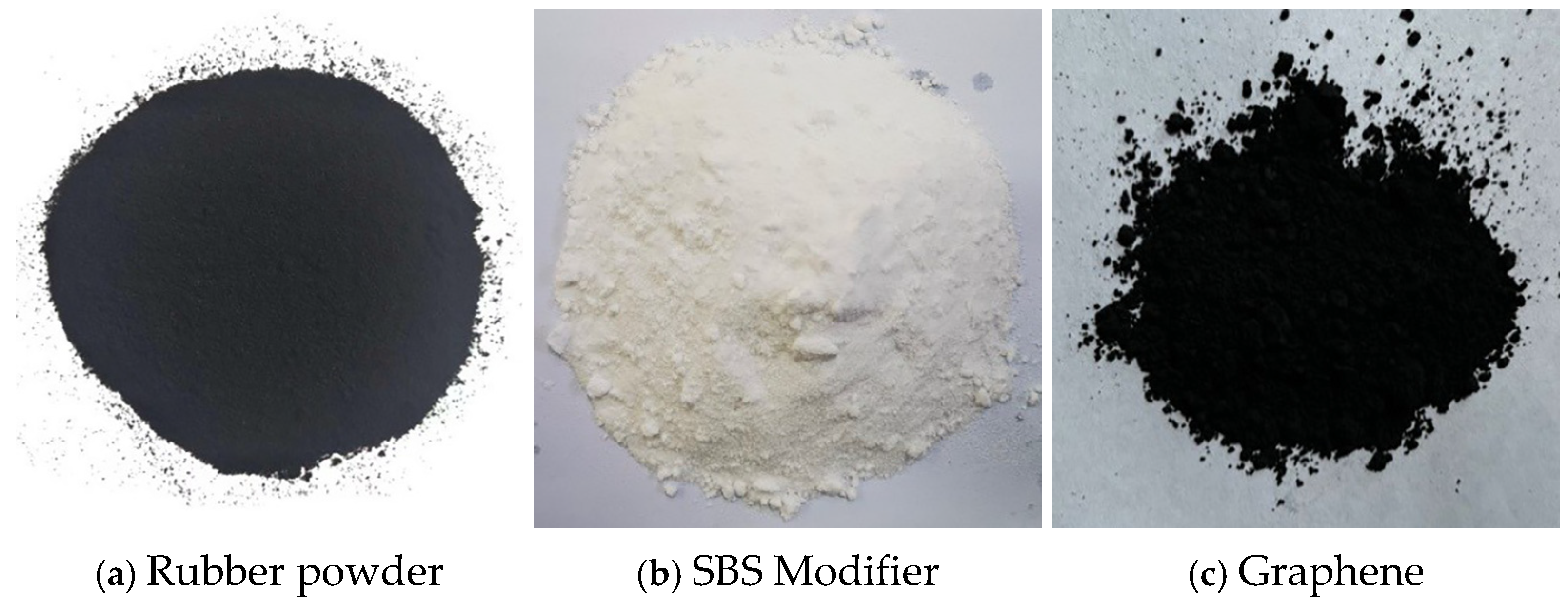
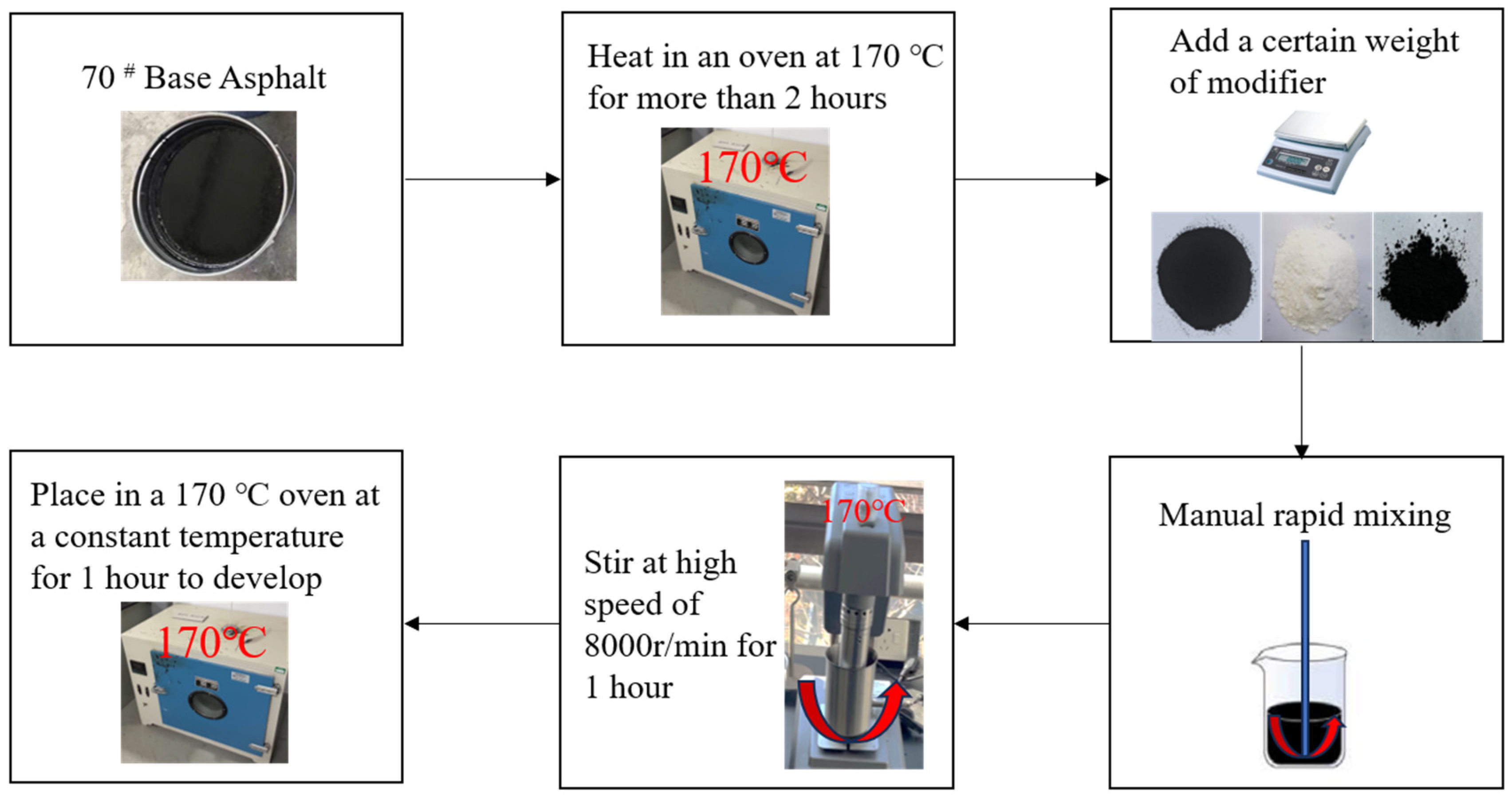
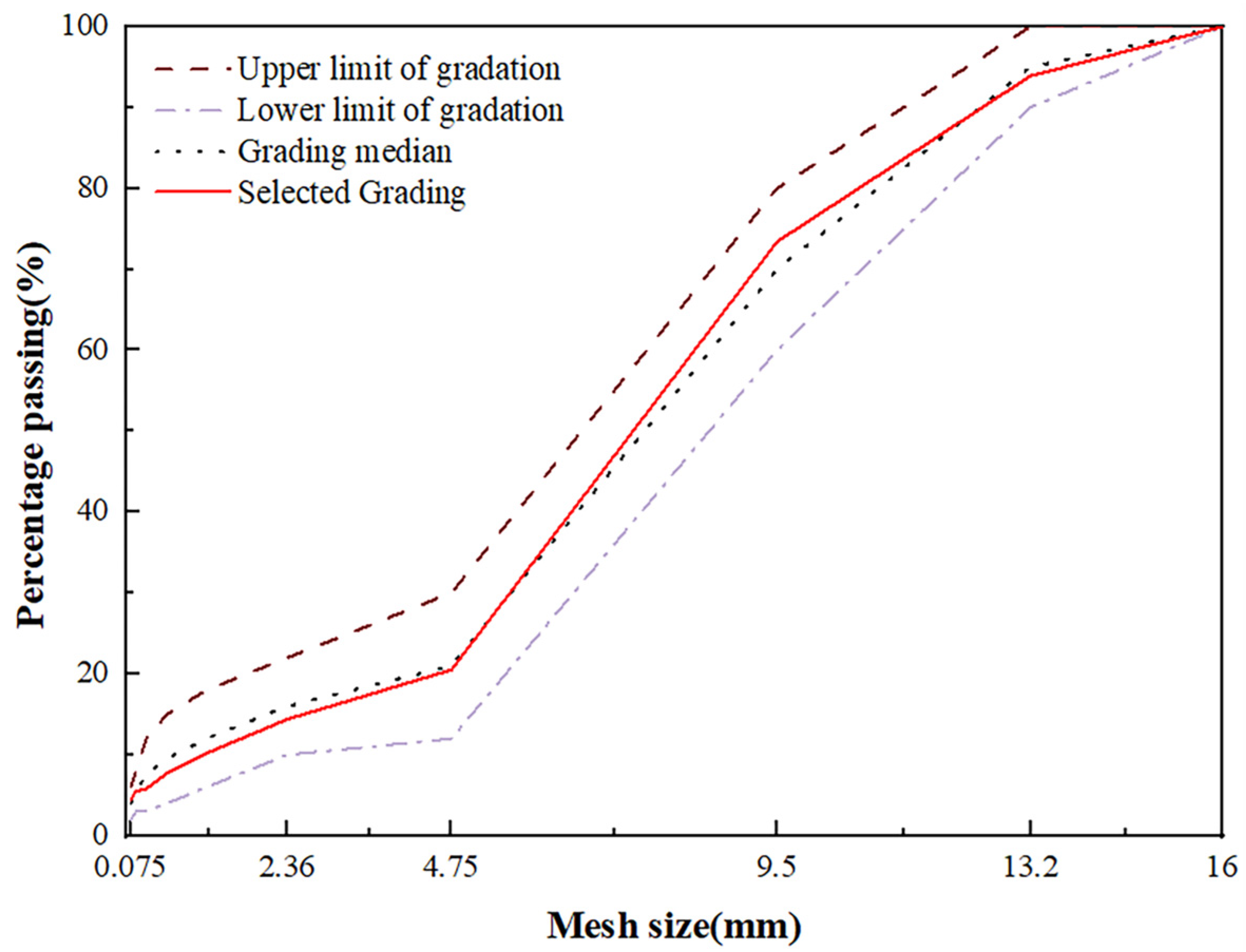
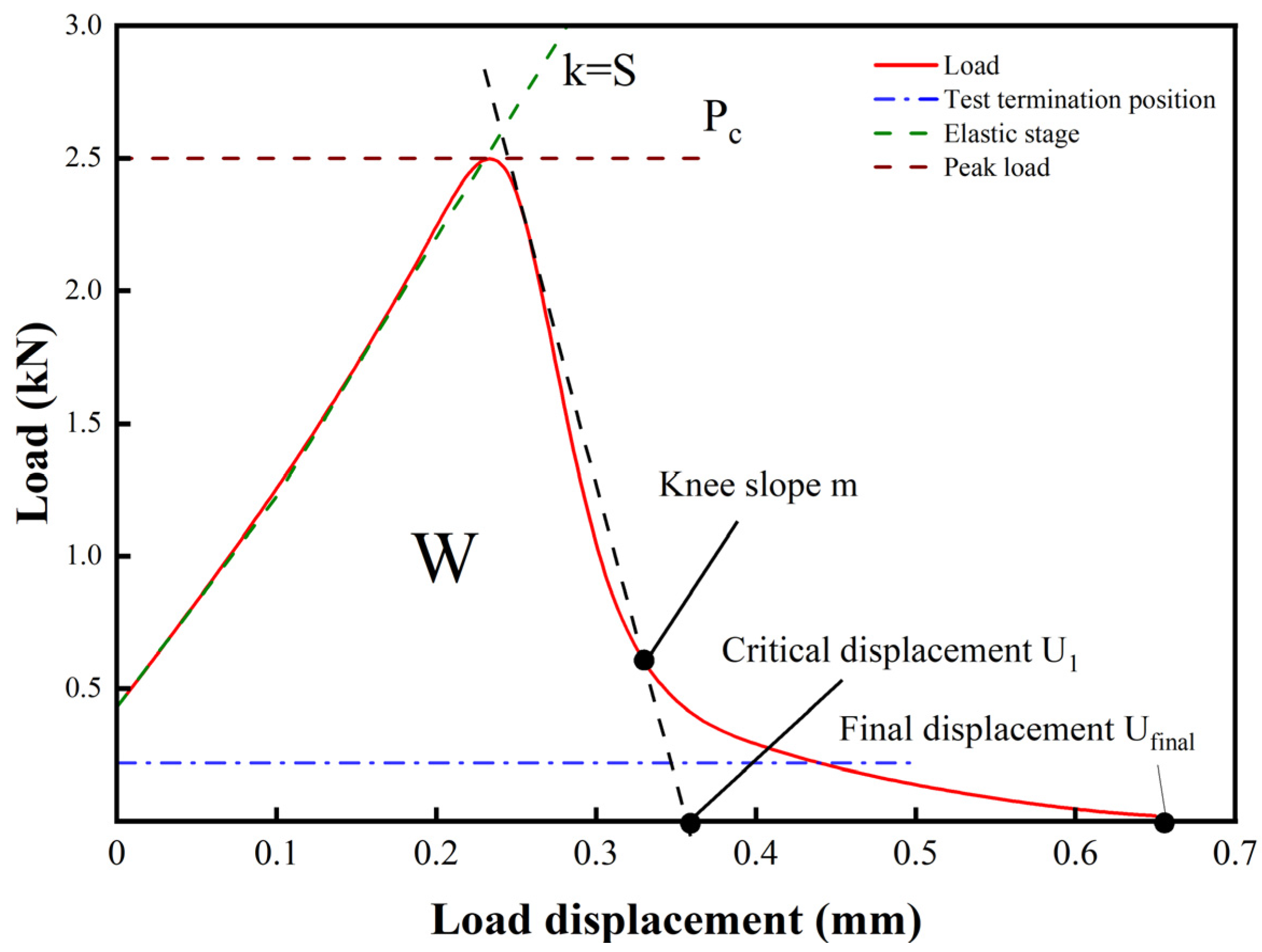
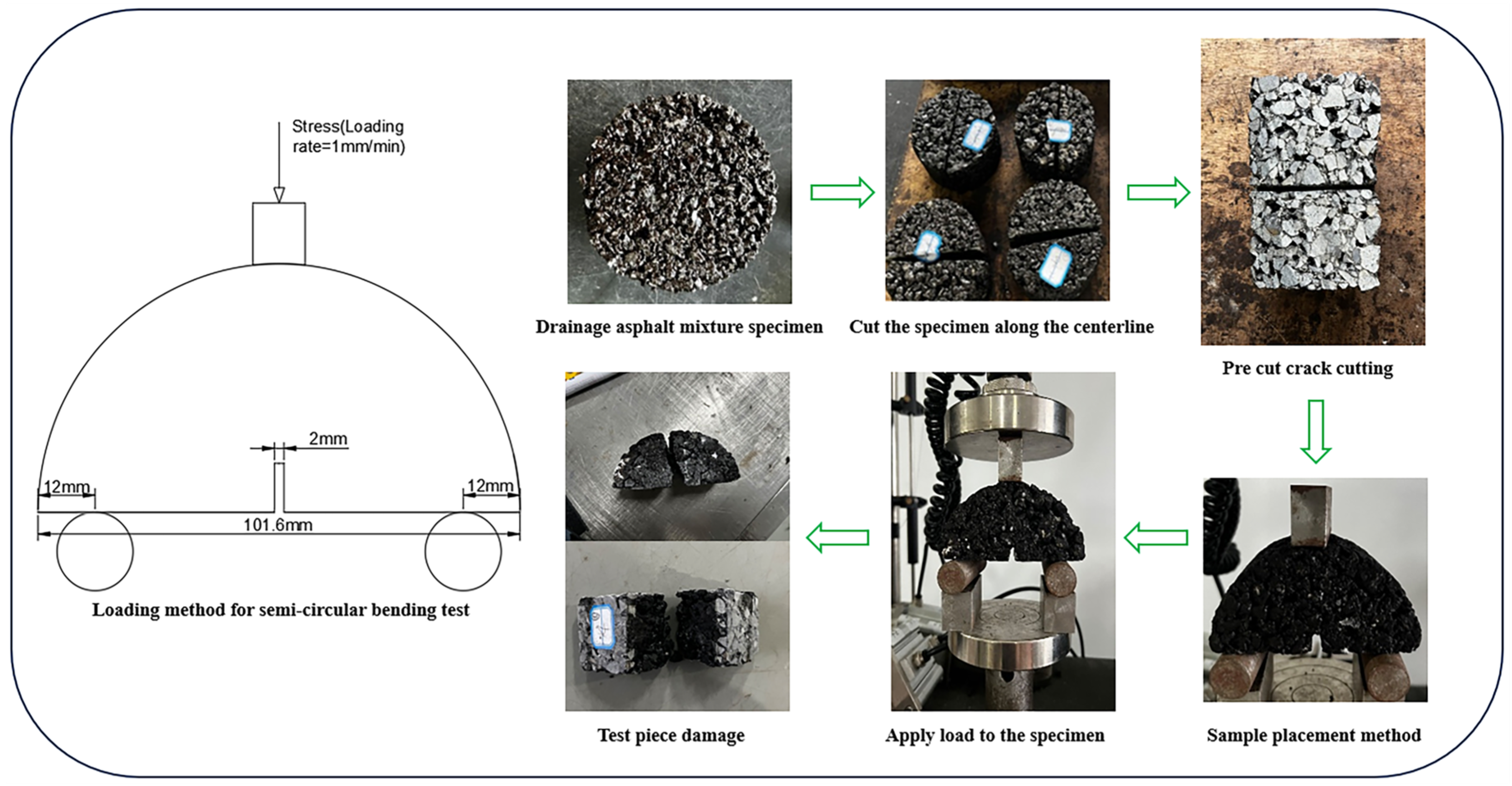

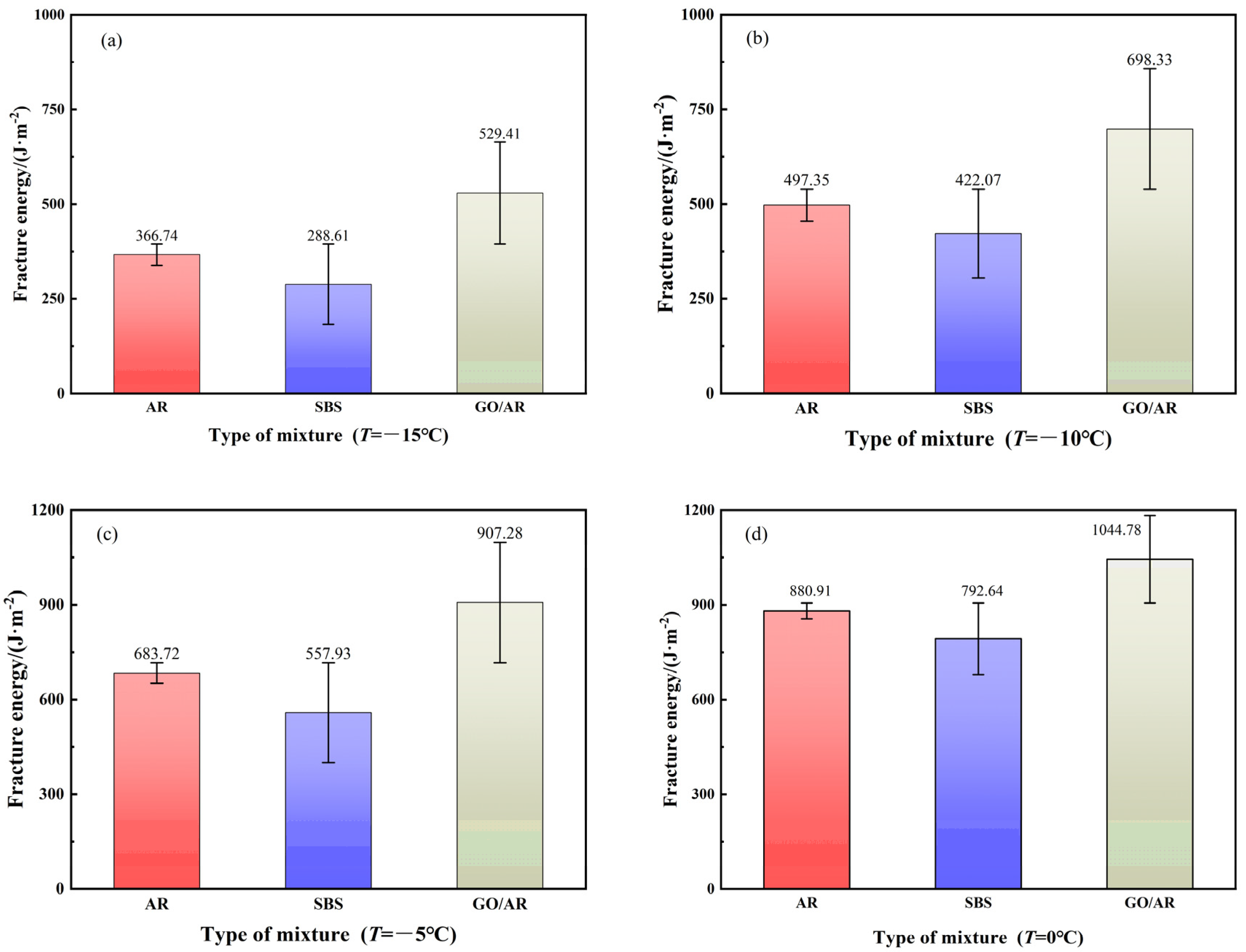
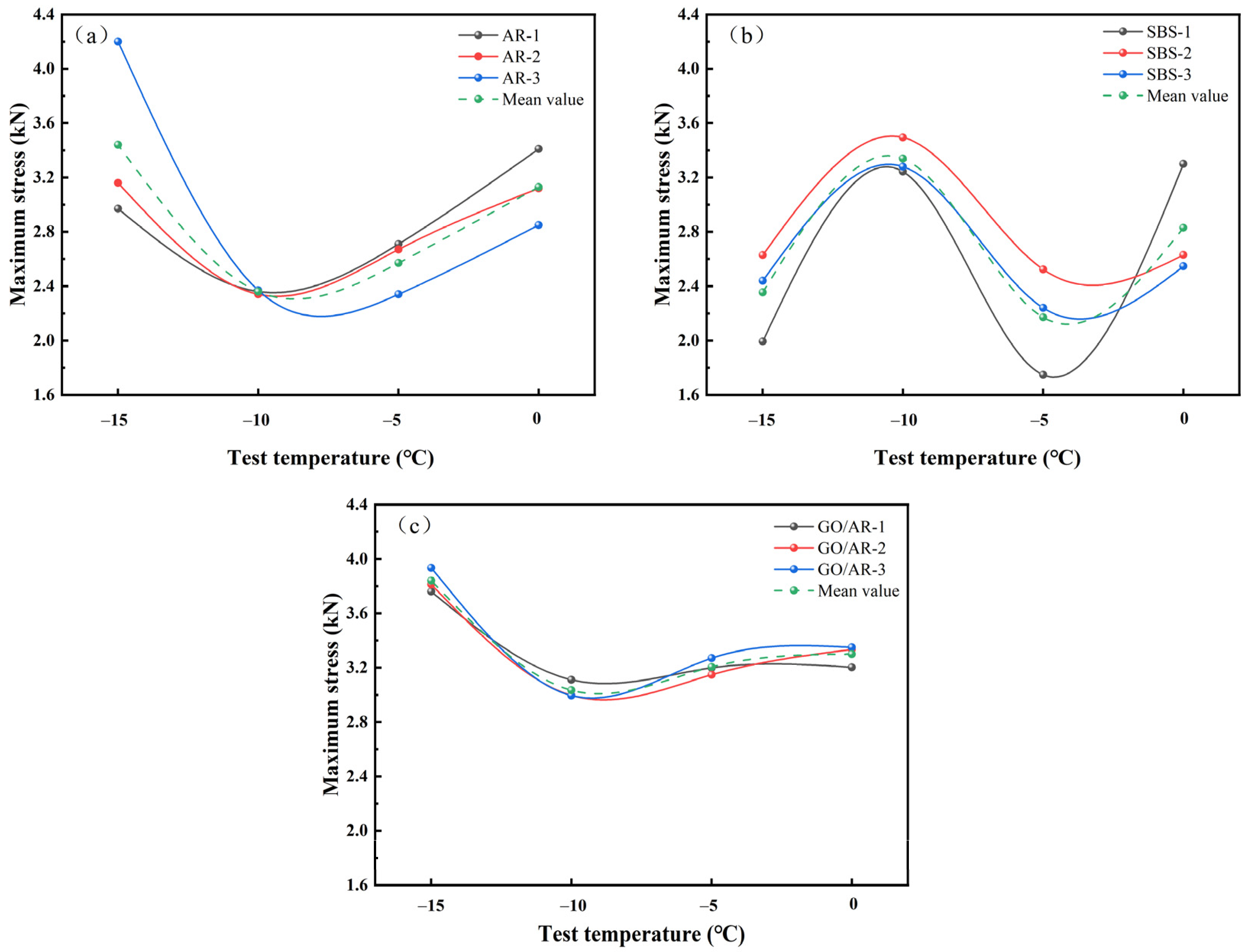
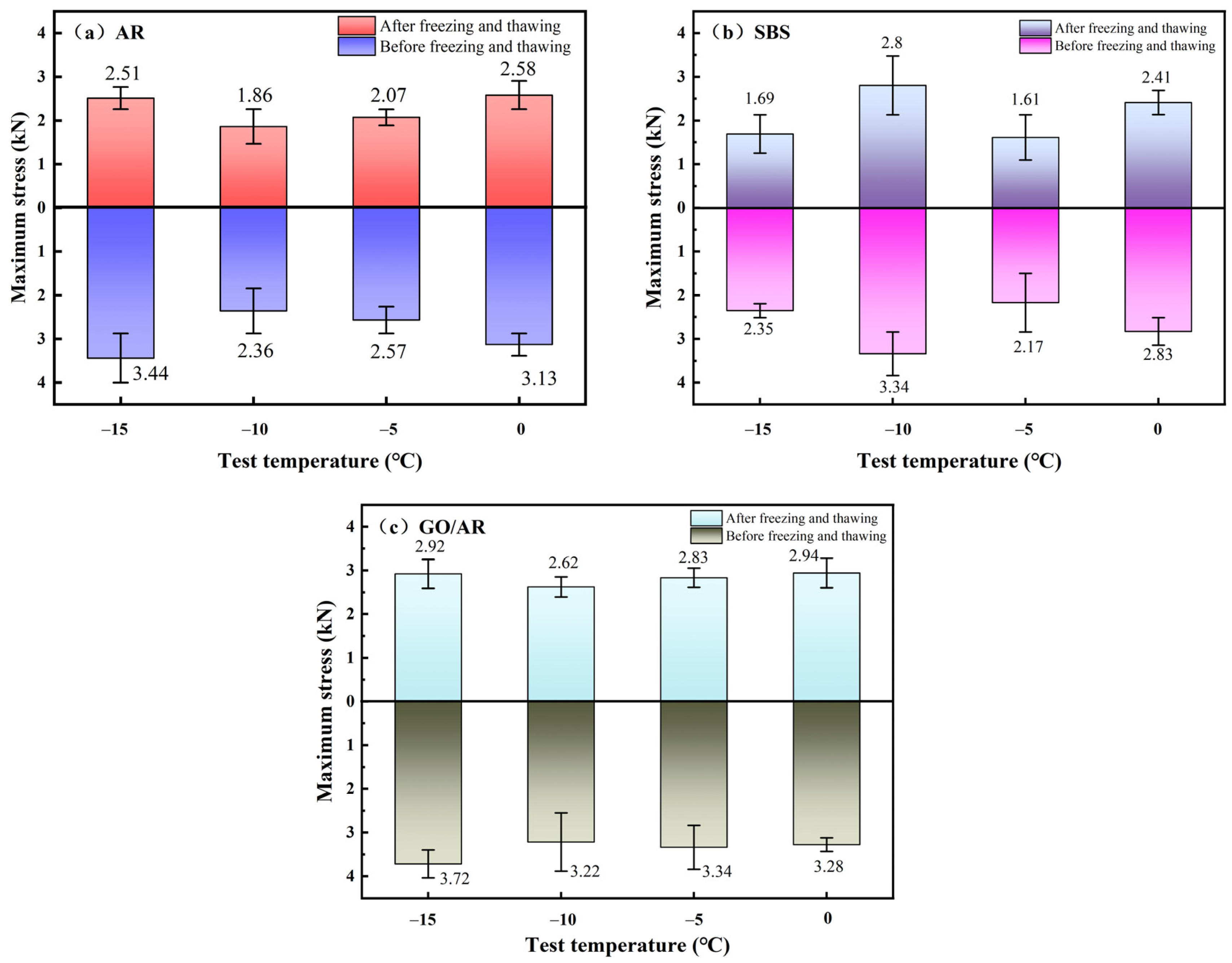
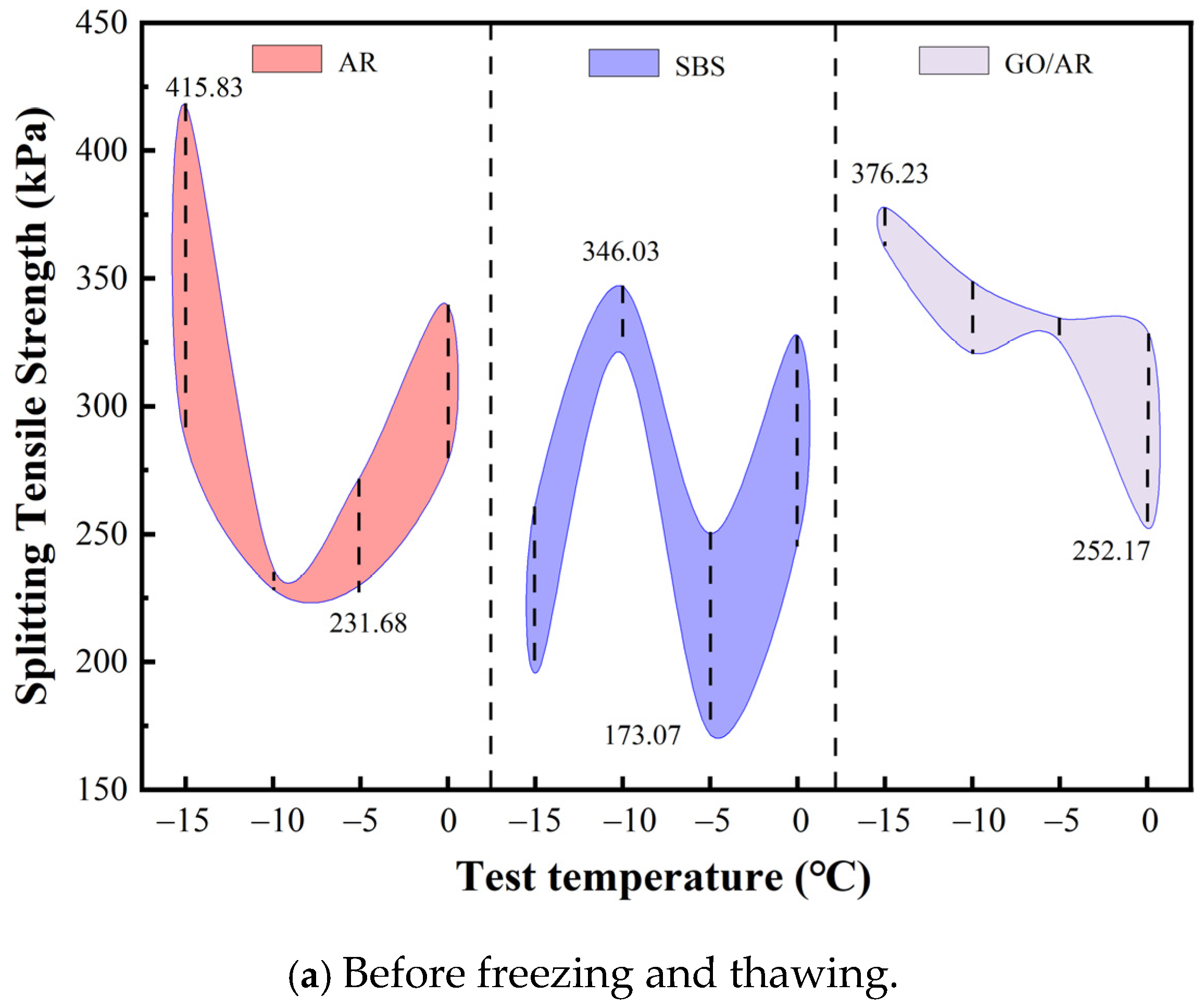
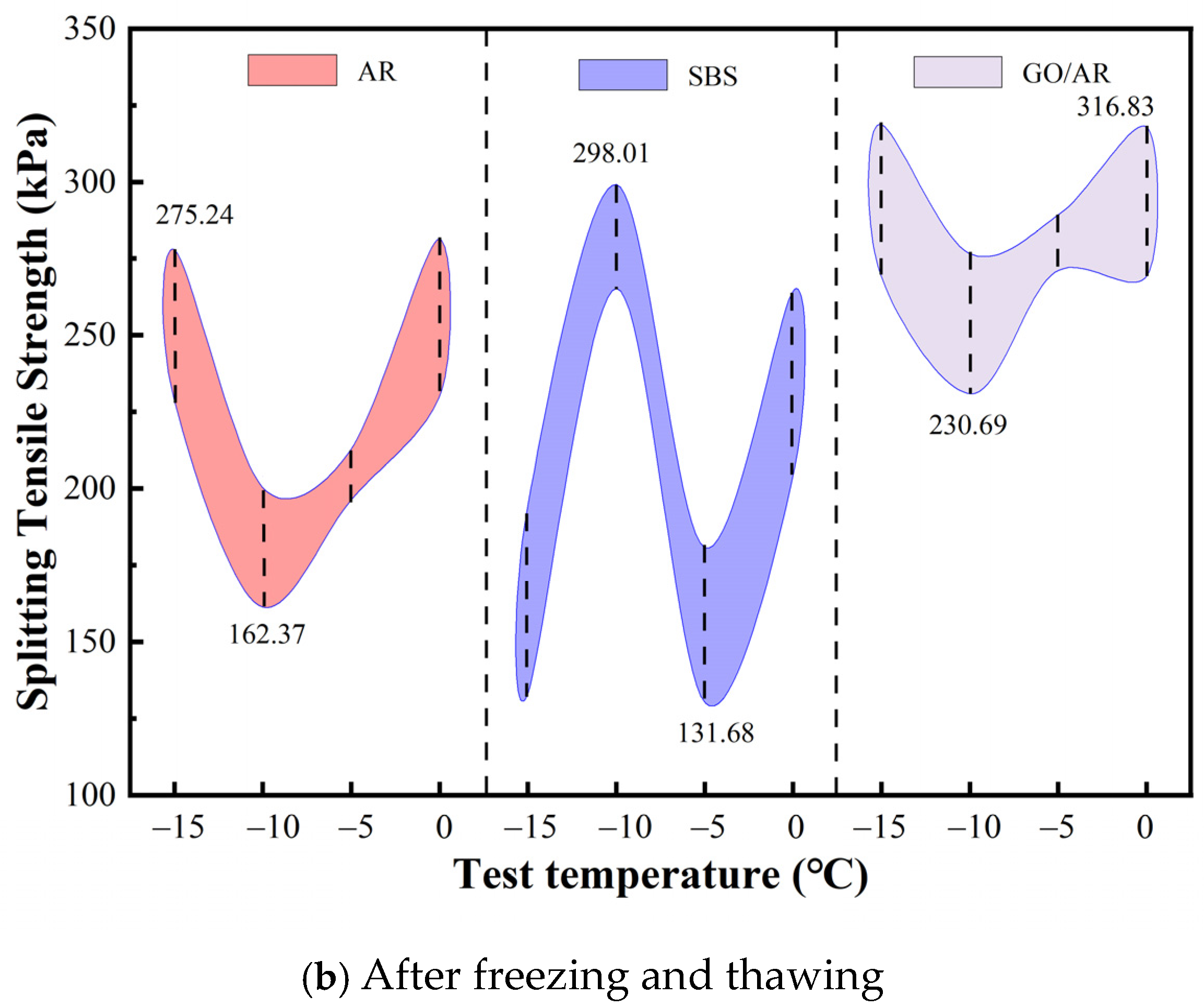
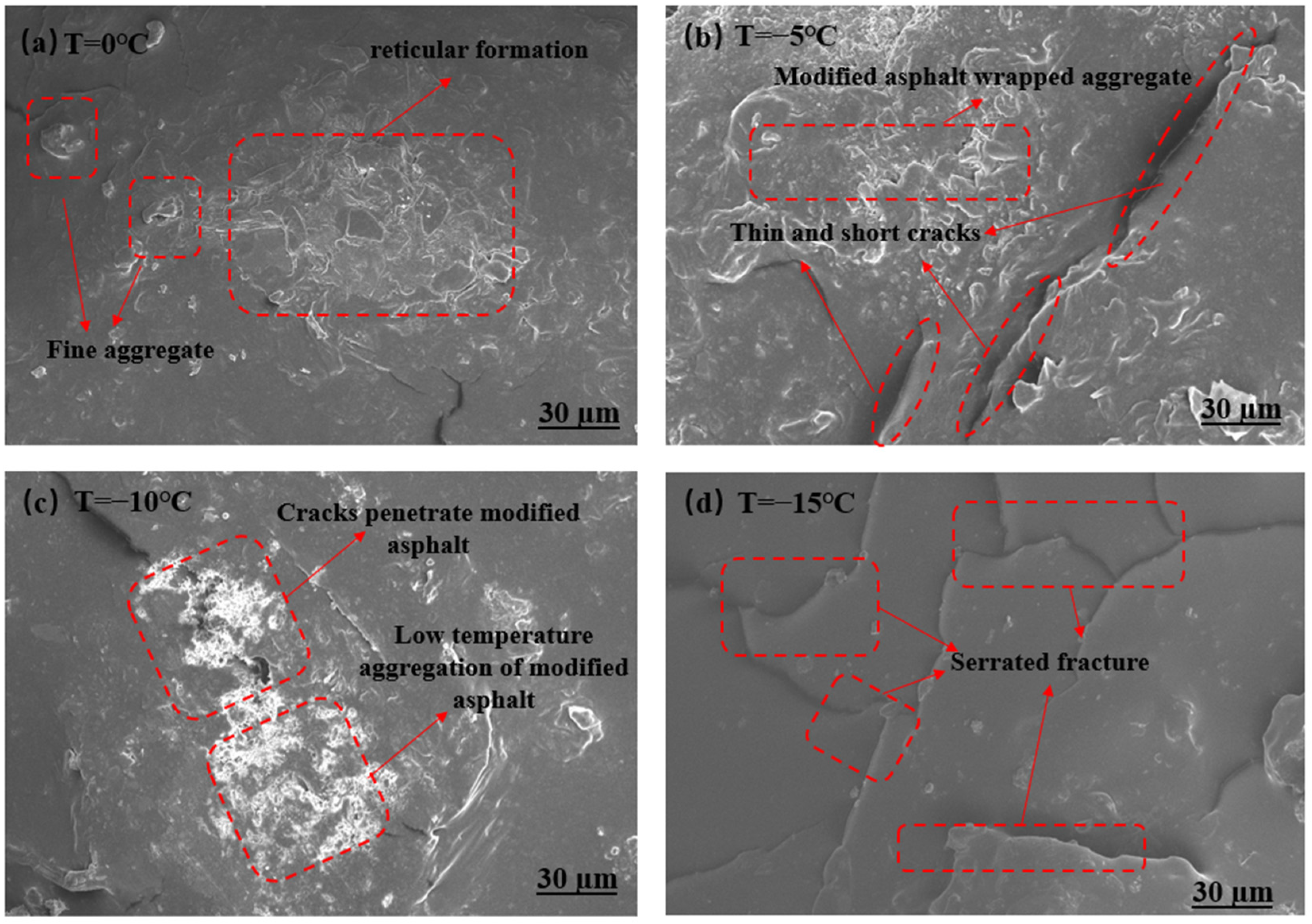
| Technical Indicators | Test Result | Technical Requirement |
|---|---|---|
| Penetration/(100 g, 25 °C, 5 s)/0.1 mm | 66.9 | 60~80 |
| Softening point/°C | 48.3 | ≥46 |
| Ductility/(15 °C, 5 cm/min)/cm | >100 | ≥15 |
| Flash point | 277 | ≥269 |
| Purity/% | Layer Size/μm | Number of Layers | Oxygen Content/% | Sulphur Content/% | Specific Surface Area/m2/g |
|---|---|---|---|---|---|
| >95 | 5–50 | 6–10 | 0.5 | 0.5 | 100–300 |
| Technical Indicators | Test Result | Technical Requirement |
|---|---|---|
| Crushing value/% | 11.2 | ≤26 |
| Los Angeles wear value/% | 10.7 | ≤28 |
| Water absorption rate/% | 0.4 | ≤2 |
| SiO2 content/% | 56.38 | / |
| Needle like particle content/% | 7.33 | ≤15 |
| Technical Indicators | AR | SBS | GO/AR |
|---|---|---|---|
| Penetration/(100 g, 25 °C, 5 s)/0.1 mm | 81.4 | 88.3 | 92.5 |
| Ductility/(15 °C, 5 cm/min)/cm | 69.4 | 72.3 | 71.4 |
| Softening point/°C | 65.3 | 52.7 | 68.4 |
| 60 °C Dynamic viscosity (kPa·s) | 28.6 | 54.6 | 32.4 |
| Actual measured average porosity (%) | 20.5 | 21.4 | 21.7 |
Disclaimer/Publisher’s Note: The statements, opinions and data contained in all publications are solely those of the individual author(s) and contributor(s) and not of MDPI and/or the editor(s). MDPI and/or the editor(s) disclaim responsibility for any injury to people or property resulting from any ideas, methods, instructions or products referred to in the content. |
© 2025 by the authors. Licensee MDPI, Basel, Switzerland. This article is an open access article distributed under the terms and conditions of the Creative Commons Attribution (CC BY) license (https://creativecommons.org/licenses/by/4.0/).
Share and Cite
Chen, J.; Cheng, Y.; Liang, K.; Cao, X.; Wang, Y.; Shen, Q. A Study on the Low-Intensity Cracking Resistance of Drainage Asphalt Mixtures by Graphene/Rubber Powder Compound Modified Asphalt. Materials 2025, 18, 3451. https://doi.org/10.3390/ma18153451
Chen J, Cheng Y, Liang K, Cao X, Wang Y, Shen Q. A Study on the Low-Intensity Cracking Resistance of Drainage Asphalt Mixtures by Graphene/Rubber Powder Compound Modified Asphalt. Materials. 2025; 18(15):3451. https://doi.org/10.3390/ma18153451
Chicago/Turabian StyleChen, Jingcheng, Yongqiang Cheng, Ke Liang, Xiaojian Cao, Yanchao Wang, and Qiangru Shen. 2025. "A Study on the Low-Intensity Cracking Resistance of Drainage Asphalt Mixtures by Graphene/Rubber Powder Compound Modified Asphalt" Materials 18, no. 15: 3451. https://doi.org/10.3390/ma18153451
APA StyleChen, J., Cheng, Y., Liang, K., Cao, X., Wang, Y., & Shen, Q. (2025). A Study on the Low-Intensity Cracking Resistance of Drainage Asphalt Mixtures by Graphene/Rubber Powder Compound Modified Asphalt. Materials, 18(15), 3451. https://doi.org/10.3390/ma18153451






